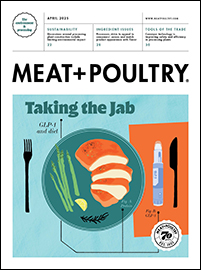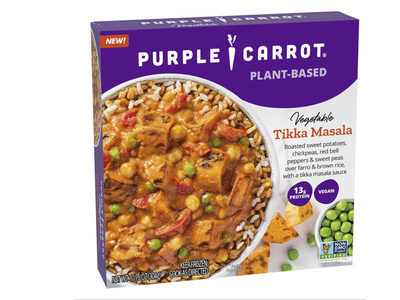For Wayne Farms LLC, new product offerings and business growth begins down on the farm, but it doesn’t end there. About three years ago, the Oakwood, Georgia-based chicken company transitioned its supply chain to accommodate customer driven demands for NAE (no antibiotics ever) chicken from one of its largest customers. Since then, Wayne Farms, a subsidiary of New York-based Continental Grain Co., has evolved quickly, offering choices to its foodservice-heavy customer base to appease today’s increasingly demanding consumers.
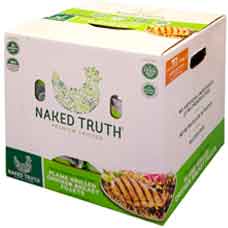 Fulfilling requests for specific production requirements, animal welfare expectations and stipulating feed type for the country’s seventh-largest vertically integrated poultry company affects the company profoundly, from operations at its feed mills, down on its farms, inside its plants and especially on the firm’s profit-and-loss statements. So, when officials recently announced that Sam’s Club would sell Wayne Farms’ Naked Truth Premium Chicken it signaled more than just toe dipping in the ultra-competitive retail segment. Offering a sous vide fully cooked chicken breast was part of the equation. But offering a flame-grilled, ready-to-eat product with claims that also include, NAE, vegetarian-fed and Global Animal Partnership (GAP) Step 2 certified had a ripple effect up and down the company’s integrated system.
Fulfilling requests for specific production requirements, animal welfare expectations and stipulating feed type for the country’s seventh-largest vertically integrated poultry company affects the company profoundly, from operations at its feed mills, down on its farms, inside its plants and especially on the firm’s profit-and-loss statements. So, when officials recently announced that Sam’s Club would sell Wayne Farms’ Naked Truth Premium Chicken it signaled more than just toe dipping in the ultra-competitive retail segment. Offering a sous vide fully cooked chicken breast was part of the equation. But offering a flame-grilled, ready-to-eat product with claims that also include, NAE, vegetarian-fed and Global Animal Partnership (GAP) Step 2 certified had a ripple effect up and down the company’s integrated system.
The November 2018 launch of its Naked Truth Premium Chicken brand at Sam’s Club stores was across 19 states, which included 221 warehouse stores. This new product initiative was the culmination of years of the poultry company’s investment in its supply chain, from farm to fork. Behind the scenes and for several years, Wayne Farms prepared for growth in new markets, including opening a new $55 million feed mill in Newton, Alabama, in 2017; investing $105 million to expand its Enterprise, Alabama, fresh processing plant; unveiling a $4.5 million customer innovation center adjacent to its Decatur prepared foods plant and renovating the Decatur West plant to accommodate a sous vide processing system.
Traditionally a foodservice-focused poultry producer and processor, debuting a premium, retail product by partnering with one of the highest-profile big-box chains in the world was a bold step into uncharted territory. Tom Bell, who was named vice president and general manager of Wayne Farms’ prepared foods business segment in 2017, says developing the Naked Truth line was the right product at the right time for retail.
“We saw this as an opportunity to offer transparency and the features that appease today’s increasingly demanding customers,” Bell says, noting the allure of a premium product offering a clean label, convenience and versatility filled a void.
The initial launch of the Naked Truth product at Sam’s will be a three-month trial. Depending on how well the product meets the expectations of the retail giant, it could become a permanent offering available at the chain of warehouse stores across the country.
Behind the scenes
But long before the new product was ready for retail, the company had to put many pieces in place to take an idea and make it a reality. Scott Forsythe, operations manager at Wayne Farms’ prepared foods plant in Decatur, got an idea after spearheading the installation of a pre-cooked, coextrusion sausage system at the plant several years ago. A 27-year veteran of Wayne Farms, Forsythe began thinking of possibilities for other product applications after seeing the successful operation of the cooked sausage technology. He and his team began exploring opportunities to cook chicken breasts. “It sparked some thinking about ‘what if’ and ‘can we,’” he says. Initial experiments included marinating and vacuum-packing small batches of chicken breasts and putting them in a cook tank “just to see what would happen,” Forsythe says.
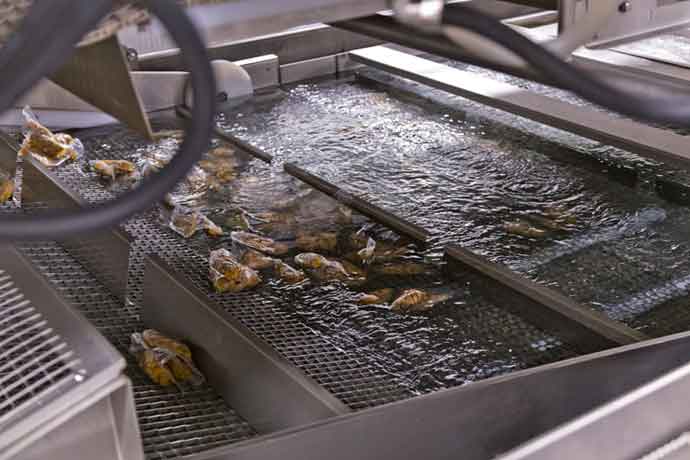
“That ultimately led to this,” he says of the sous vide process.
After some trials and errors experimenting with crude versions of sous vide, the decision was made to bring on a dedicated expert to focus on developing a new sous vide, ready-to-eat premium chicken product. In 2015, Beau Batchelor was hired as the research and development manager. He is regarded as the in-house expert on sous vide cooking and applications for Wayne Farms.
Batchelor says John Anderson, director of research and development, was hired to spearhead the company’s investment in sous vide technology and applications. While working together at another company about nine years ago, Anderson remembers, “Beau used to bring his circulator in and sous vide stuff to show people what it could do,” in hopes that the technology would be adopted by that company. “Nobody would go for it,” says Anderson of what was then considered too unconventional. “It was new, unique and it’s not what chicken people traditionally do.”
So, it wasn’t much of a sell when Anderson mentioned the possibility of bringing Batchelor on board at Wayne Farms when the company committed to utilizing the technology he had believed in for years.
According to Batchelor, “They said, ‘we’re going to do this, would you like to help?’ and I said ‘absolutely.’”
Three years later, sous vide has become an important part of Wayne Farm’s offerings, first for its foodservice customers using Wayne Farms’ NAE chicken and more recently for Sam’s, using chicken raised on antibiotic free, vegetarian feed in GAP level 2 certified poultry houses.
“No piece of Naked Truth sous vide happened by accident. It’s all been thought through; it’s all been strategic and articulated the way it is by design.” Sarah Wilbourn, foodservice distribution sales manager
Batchelor says the sous vide technology behind the Naked Truth retail product is proven and effective but it isn’t a silver bullet and can’t mask sub-par raw product. The quality of the product begins on the farm and “If you don’t start with something nice it’s definitely not going to finish right,” he says. “With sous vide, it’s a closed system. Whatever goes in is going to come out, so you can’t start with bad raw material. We start with the best we possibly can.
“We’re using chicken and we’re using the process. The idea is to get the best piece of grilled chicken,” Batchelor says, and while sous vide is an important part of the process, “it’s only a piece of the puzzle; it’s not just about the preparation.”
While focusing on optimizing each breast fillet for the sous vide line of products, Batchelor is also working with Wayne Farms’ product developers to create opportunities for the rest of the bird. This includes dark meat alternatives that are traditionally sold to the export market. “It’s all about finding the right product for the right customer,” Batchelor says. For the right foodservice operator, that product could be a labor-friendly new dark-meat menu item that creates differentiation from the competition.
Getting prototypes in front of consumers to taste test and provide feedback early in the process was the biggest part of the Naked Truth line’s development, according to Batchelor. Initially tasting panelists asked lots of questions about the product, including how it was produced and why it looked like it did until, through trial and error, the team came up with a tapered, natural-looking chicken breast. “And then those questions just went away,” he says. “The questions around processing stopped.”
Multiple choice chicken
The commitment to offer choice to its customers has always been a hallmark of Wayne Farms, according to Bell, and Naked Truth is the latest example of that. Vertical integration is a significant advantage to the company, allowing it to produce the feed, operate the hatcheries and work directly with the family farms raising the chickens.
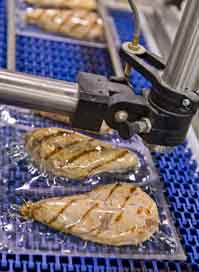 Whether it is the premium, Naked Truth product or the NAE chicken breasts, the shape of the sous vide cooked product is the same. Weights depend on the customer, usually either 4 oz., 5 oz. or 6 oz. Wayne Farms portions its chicken breasts to be uniform, trimming them using JBT’s DSI, water-cutting technology to create a teardrop-shaped final product. Some of the Naked Truth product trimmings are sold to quick-serve customers, and Wayne Farms product developers are experimenting with other options, including diced products. It’s all about trying to figure out the best use for the leftover products after the teardrop-shaped chicken breast is removed, says Sarah Wilbourn, foodservice distribution sales manager. She says product developers are always on the lookout for new opportunities and asking, “Are there applications for the trim part in sous vide? What can we do from there? For example, can we do medallions or chunks or what makes sense in our system?” This could result in manufacturing products suited for meal kits, she says.
Whether it is the premium, Naked Truth product or the NAE chicken breasts, the shape of the sous vide cooked product is the same. Weights depend on the customer, usually either 4 oz., 5 oz. or 6 oz. Wayne Farms portions its chicken breasts to be uniform, trimming them using JBT’s DSI, water-cutting technology to create a teardrop-shaped final product. Some of the Naked Truth product trimmings are sold to quick-serve customers, and Wayne Farms product developers are experimenting with other options, including diced products. It’s all about trying to figure out the best use for the leftover products after the teardrop-shaped chicken breast is removed, says Sarah Wilbourn, foodservice distribution sales manager. She says product developers are always on the lookout for new opportunities and asking, “Are there applications for the trim part in sous vide? What can we do from there? For example, can we do medallions or chunks or what makes sense in our system?” This could result in manufacturing products suited for meal kits, she says.
The Naked Truth line competes with other fully cooked chicken breasts already on the market, so it had to have some valid attributes that made it stand out. Comparable products don’t look as natural, Wilbourn says. For starters, the competitions’ products don’t pass the eye test. “They just look processed,” she says, and none of them can make all the production claims, use sous vide cooking or feature a label that is as clean. “No piece of Naked Truth sous vide happened by accident,” Wilbourn says. “It’s all been thought through; it’s all been strategic and articulated the way it is by design.”
The goal of reinventing a foodservice quality and making it available to consumers to easily prepare at home was achieved thanks to the collaboration of Wayne Farms’ R&D team, its culinary expert with plenty of input from operations experts.
“The attention to detail, from the beginning all the way to your plate, on your fork and in your mouth has been insane,” says Jana Brackett, marketing analyst at Wayne Farms.
Retail appeal
Making the leap from foodservice to retail presented some challenges, according to most of the Wayne Farms team working on the development and launch of Naked Truth.
The product is designed to be served cold or hot, whole or sliced, according to Frank Jock, Wayne Farms’ corporate chef. “I can grill it, I can microwave it, I can pan-sear it, I can drop it in water and it will turn out the same,” he says.
When it comes to culinary applications, “The bullseye is so big on it,” says the chef, who routinely serves up examples of the products’ versatility for current and potential customers at the company’s new innovation center, where a commercial test kitchen, pilot plant and meeting areas promote innovation and collaboration.
“The Naked Truth brand is built around telling a story, so our customers don’t have to,” says Megan Ernst, senior brand manager. She adds that telling![Naked Truth brand birds are raised in compliance with Global Animal Partnership [GAP] Step 2 standards.](/ext/resources/MPImages/01-2019/wayne-farms-chicken-house.jpg) that type of story is less challenging in the retail environment, where shoppers are typically receptive to learning more about the food they’re buying. Ernst points out that the Naked Truth retail package serves as a giant billboard for the product. The real estate available on the packaging is used to spotlight the features of Naked Truth chicken, including production claims, GAP-2 compliance, sous vide cooking and even the flame-grilled attributes, thanks to a product photo and a clear window that is part of the resealable, stand-up pouch.
that type of story is less challenging in the retail environment, where shoppers are typically receptive to learning more about the food they’re buying. Ernst points out that the Naked Truth retail package serves as a giant billboard for the product. The real estate available on the packaging is used to spotlight the features of Naked Truth chicken, including production claims, GAP-2 compliance, sous vide cooking and even the flame-grilled attributes, thanks to a product photo and a clear window that is part of the resealable, stand-up pouch.
So, launching the new product at retail first just made sense. Wilbourn and others realized that conveying the new product’s story to foodservice probably would have been a tougher sell. “Some of the challenge is how do we help people in foodservice who may or may not use the Naked Truth brand, to see the value of going from NAE, small-bird, veg-fed to Naked Truth.” The difference with Naked Truth, she says, is the growing and raising of the birds in compliance with GAP Step 2 standards. As part of the GAP program, chickens used to produce the Naked Truth line are raised indoors, in cage-free chicken houses where lower density standards must be met, lighting systems to simulate natural light patterns, and at least two enrichment types available to the animals, such as perches or huts to encourage natural behaviors. Plans are underway to further enhance the GAP-compliant chicken houses with windows or light tubes to provide natural sunlight. In 2019, Wayne Farms is also planning to transition to controlled atmosphere stunning at its slaughter operation in Enterprise as part of its commitment to improving animal welfare.
Ready, set…retail
Wilbourn admits there was a learning curve for making the retail leap after the company’s long history of supplying restaurants.
“We’re a foodservice company, but we very quickly realized that sous vide could be a home run with consumers. Add to that the Naked Truth branding 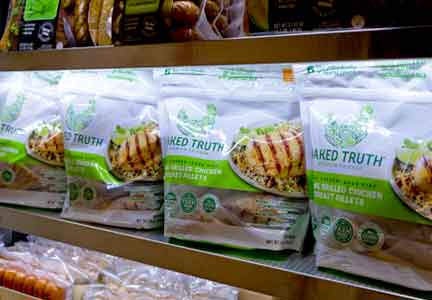 and it doesn’t get any better than that,” Wilbourn says. The target audience at retail includes millennial mothers shopping for a premium product for their kids. “It’s just a perfect fit,” she says. But making the product fit was part of a transitional process.
and it doesn’t get any better than that,” Wilbourn says. The target audience at retail includes millennial mothers shopping for a premium product for their kids. “It’s just a perfect fit,” she says. But making the product fit was part of a transitional process.
As of mid-December, the only production of Naked Truth branded sous vide products was being done for Sam’s Club, but other major retailers are showing interest.
Upstream excellence
Raw materials for the Naked Truth retail products are shipped twice a week from the Wayne Farms primary processing plant in Dothan, Alabama, to its Decatur prepared foods plant about 280 miles north. When the Naked Truth product isn’t being processed, the facility is producing NAE products for foodservice distribution, including Wayne Farms’ Chef’s Craft line.
The Decatur East plant, which has been in operation since 2008, was renovated in 2017 to accommodate marinating technology and adding thermal processing equipment, a sous vide cooking system and packaging equipment. About 425 people work in the East plant, where two shifts per day are the norm and operations also include a co-extrusion sausage line. For the sous vide processing operation, about 62 employees were added for production, maintenance and quality assurance.
The sous vide system, says the resident guru, Batchelor, was designed specifically for lean protein. Deciding on the technology to deliver the desired end product was a big part of Batchelor’s role in the introduction of Wayne Farms’ sous vide offerings. He and his team shopped many companies’ sous vide equipment before deciding on the Unitherm Aquaflow. He says it was a trial-and-error process. “We tested all kinds of things to make it happen, to get the product we wanted,” Batchelor says, without compromising on quality attributes.
Processing prowess
After the raw product arrives at the Decatur East plant, it works its way toward the sous vide cooking system, but each breast is first lightly seasoned and slowly tumbled in a broth-based marination combined with dry ingredients, including salt, black pepper, cherry powder and celery powder. The goal, Batchelor says, is to alter the breast meat as little as possible. The few ingredients used in the marinade are listed on the product label, he adds. “We try to maintain as much natural texture as we can. We want it to be as savory as possible without any polarizing flavors,” and the exact amount of those ingredients is tweaked, according to the requirements of the customer. “We try to get maximum impact for what the customer will allow us to do,” says Batchelor of the formulation process.
After tumbling and before packaging and cooking, the breasts go through a primary thermal process that seals in flavor and provides an appetizing grill mark on every product. The grill-marking process isn’t only for looks, says Batchelor, as each breast goes through a Unitherm “Tunnel of Fire” flame griller to first sear it on all surfaces. Next, a system of slowly rotating, red-hot grill markers deliver blackened stripes on the products before they exit the equipment. “It’s not just a grill marker. We’re actually subjecting it to a flame so you’re getting that top note without it being too strong,” Batchelor says.
Anderson, from R&D, says the searing and marking process is designed to enhance appearance and taste and the process is the result of plenty of experimentation. Prototypes were seared with MAP gas-fueled blowtorches, to duplicate the flame tunnel.
“In my 27 years with this company, this is the best product I’ve ever been a part of producing. I love this stuff. It’s just a fantastic, extremely flexible product.” Scott Forsythe, operations manager, Wayne Farms
“The way this whole thing was developed isn’t like any other chicken item,” Anderson says. Careful steps taken throughout processing, including designating line workers to line up fillets on the conveyor before they are seared and marked to ensure the conveyor space is maximized and the grill marks are uniformly diagonal.
The seared product is then conveyed to the packaging area where it is vacuum sealed, leaving just enough air in the package to avoid disfiguring the breast inside. After packaging in either three-packs for foodservice or single-packs for the Naked Truth line, the products travel up a spiraling conveyor to the elevated cooking system.
The heart of the sous vide operation includes a three-tier, water-based cooking system. The Unitherm Aquaflow equipment is about 63-ft. long and 17-ft. tall. “It’s like a submarine in the middle of a room,” Batchelor jokes. The cooking process for the Naked Truth product requires the individually wrapped, 5-oz. breasts to dwell in constantly circulating hot water to achieve a final cooking temperature within one degree of its predetermined, validated target. It then drops to the lowest level where it’s cooled before being conveyed through a drying system not unlike a miniature car wash.
The retail-bound Naked Truth products are loaded in stand-up pouches, each holding six individually packaged breasts. After cooking and packaging at the Decatur plant, Sam’s requires the products are shipped frozen, so the pouches are sent to a third-party company to be frozen. For foodservice customers, the NAE products are sold fresh and are never frozen. The refrigerated shelf life for the Naked Truth sous vide products is a surprising 70 days.
A processing veteran of Wayne Farms who has seen dozens of new product innovations during his tenure, Forsythe says the sous vide technology combined with the Wayne Farms production methods utilized to produce Naked Truth are game changers.
“In my 27 years with this company, this is the best product I’ve ever been a part of producing. I love this stuff,” Forsythe says. “It’s just a fantastic, extremely flexible product.”
